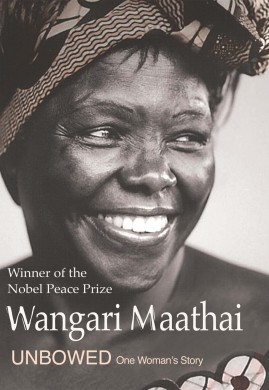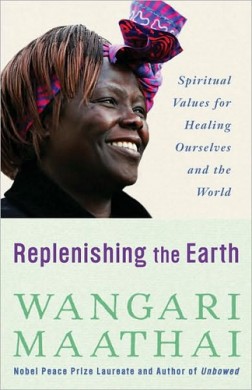There are many ways of helping to build a better world. Depending on their own talents, different people choose different ways. They may choose to become leaders, educators, mentors, coaches, writers, artists, filmmakers, social entrepreneurs, activists or whatever.
Wangari Maathai combined many of these roles. She was born in 1940, the third of six children, in a traditional mud hut with no electricity or running water. She went on to enable many people to shape their future lives.
Whilst best known for her work with the Green Belt Movement in Kenya, she also acted as a positive model for people.
During her life she recruited hundreds of thousands of people who planted more than 40 million trees. She also encouraged people to harness their inner strength.
Wangari recognised that she was fortunate because her family sent her to a primary school run by Italian nuns.
Showing great academic aptitude, she won a scholarship to the United States, being part of what was called ‘The Kennedy Airlift’. This involved some 300 Kenyans being chosen to study at American Universities.
After further study in Germany, she returned to Kenya. After working as a vet in some of the poorest areas, Wangari led academic departments in the University of Nairobi.
Extremely practical and logical (she was the first Kenyan woman to gain a Ph.D.), her work sprang from a philosophical base.
She believed it was vital to respect and live in harmony with nature. She wrote:
“We must repent our sins (i.e. rectify our wrongdoings) by dressing our motherland in her original beautiful and full green dress. In planting trees, we are adorning our motherland with belts …
“When we have repented (i.e. rectified, our motherland will be healed and we shall reap a bounteous harvest.”
Wangari was often asked if the idea for the Green Belt Movement came to her because she was a woman. Acknowledging that women bear life and respect nature, she said it was simply searching to solve a specific problem.
This involved helping people to climb out of poverty, replenish the earth and enjoy the fruits of their labours. She wrote:
“Inspirations come to all of us but many of us may not have the right mental peace and tranquility at the critical time to allow the inspiration to grow beyond the stage when it appears like a dream.
“I think I was just lucky. I do not know why I nursed the inspiration until it became an idea and finally an activity.
“I think that women in the NCWK (National Council of Women in Kenya were quite good at pursuing an idea which for a long time bore little fruit. But patience is not the prerogative or women.”
Tree planting became an honourable activity in Kenya, said Wangari. This led to creating thousands of greenbelts in the country and soon spread to other countries in Africa.
The act of planting trees enabled the earth to breath and the crops to grow. Showing it was possible to make a difference encouraged people to take more charge of their human rights.
Wangari achieved much in her life before her death in 2011. By then she was acknowledged as a pioneer and honoured in many countries. Here are just some of the awards she was given.
1984: Right Livelihood Award, Sweden
1991: The Goldman Environmental Prize, Goldman Foundation, USA.
1991: The Hunger Project’s Africa Prize For Leadership, United Nations.
1993: The Jane Addams Leadership Award, USA.
1993: The Edinburgh Medal, Medical Research Council, Scotland.
1994: The Order of The Golden Ark Award, The Netherlands.
2004: Nobel Peace Prize, The Norwegian Nobel Committee, Norway.
2004: Elder of The Golden Heart, Republic of Kenya.
2006: The Kenya National Commission on Human Rights Milele (Lifetime) Achievement Award.
2006: Legion D’Honneur, Government of France.
2006: Disney Wildlife Conservation Fund Award, USA.
2006: The Indira Gandhi International Award for Peace, Disarmament and Development, India.
2006: Medal for Distinguished Achievement, University of Pennsylvania, USA.
2007: The Nelson Mandela Award for Health and Human Rights, South Africa.
2007: The Jawaharial Nehru Award for International Understanding, India.
2008: Dignitas Humana Award, St. John’s School of Theology, USA.
2008: Royal Institute of British Architects (RIBA) Honorary Fellowship, UK.
2009: The Order of The Rising Sun, Japan.
2010: Earth Hall of Fame, Kyoto, Japan.
The Green Belt Movement’s work continues in Kenya and also internationally. Here are the aims as stated on the organisation’s web site.
http://greenbeltmovement.org/index.php
The mission of the Green Belt Movement International (GBMI) is to empower communities worldwide to protect the environment and to promote good governance and cultures of peace. GBMI has four goals:
Goal 1: To strengthen and expand the Green Belt Movement in Kenya.
Goal 2: To share the Green Belt Movement’s programme with other countries in Africa and beyond.
Goal 3: To empower Africans, especially women and girls, and nurture their leadership and entrepreneurial skills.
Goal 4: Advocate internationally for the environment, good governance, equity and cultures of peace.
Generous people often create an environment that enables people and things to grow. Wangari Maathai chose her way to encourage future generations.
She wrote: “My little thing is planting trees.”
This created a remarkable legacy that continues to inspire people.








Leave a Reply